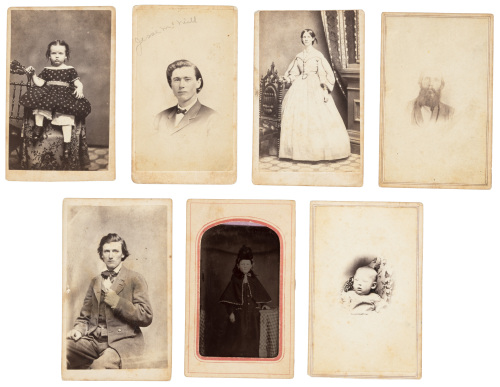Rare CDV featuring William Soule standing next to his camera. Verso with H. Bishop's New Sky Light Gallery, Chambersburg, PA imprint. Soule is pictured here with one arm resting atop the large camera. William Stinson Soule (1836-1908), of Boston, served a full three year enlistment in "A" Co., 13th Massachusetts Infantry, despite being wounded at Antietam. Already possessing a knowledge of photography due to assisting at his older brother John P. Soule's well-established Boston studio prior to the war, Will traveled west with his equipment in 1867. Having saved up some money working as a store clerk in Fort Dodge, Kansas, and inspired by the publication of his photograph Scalped Hunter as an engraving in Harper's Weekly in early 1869, Soule moved on to Fort Sill, Indian Territory to open his own studio. General Philip Sheridan had established the cavalry outpost in January of that year in order to defend attacks on border settlements in Texas and Kansas from within Indian Territory and, with this type of security, Soule was able to photograph Indians as few before him had. He stayed in the area until 1874, when he returned to Boston to again partner with his brother, who helped Will copyright and market the exceptional images. Today, Soule's photographs of Kiowa, Wichita, Comanche, and others, are recognized as some of the most important photographs of their type and reside in several prominent public and private collections Condition: CDV with a mottled effect in the print, light soiling to surface, and light wear to edges and corners (including some peeling/separation of mount layers in bottom corners).
Rare CDV featuring William Soule standing next to his camera. Verso with H. Bishop's New Sky Light Gallery, Chambersburg, PA imprint. Soule is pictured here with one arm resting atop the large camera. William Stinson Soule (1836-1908), of Boston, served a full three year enlistment in "A" Co., 13th Massachusetts Infantry, despite being wounded at Antietam. Already possessing a knowledge of photography due to assisting at his older brother John P. Soule's well-established Boston studio prior to the war, Will traveled west with his equipment in 1867. Having saved up some money working as a store clerk in Fort Dodge, Kansas, and inspired by the publication of his photograph Scalped Hunter as an engraving in Harper's Weekly in early 1869, Soule moved on to Fort Sill, Indian Territory to open his own studio. General Philip Sheridan had established the cavalry outpost in January of that year in order to defend attacks on border settlements in Texas and Kansas from within Indian Territory and, with this type of security, Soule was able to photograph Indians as few before him had. He stayed in the area until 1874, when he returned to Boston to again partner with his brother, who helped Will copyright and market the exceptional images. Today, Soule's photographs of Kiowa, Wichita, Comanche, and others, are recognized as some of the most important photographs of their type and reside in several prominent public and private collections Condition: CDV with a mottled effect in the print, light soiling to surface, and light wear to edges and corners (including some peeling/separation of mount layers in bottom corners).















Testen Sie LotSearch und seine Premium-Features 7 Tage - ohne Kosten!
Lassen Sie sich automatisch über neue Objekte in kommenden Auktionen benachrichtigen.
Suchauftrag anlegen